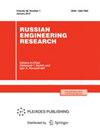Remote Sensing Data in Assessing Urban Density
Q3 Engineering
引用次数: 0
Abstract
The possibility of using remote sensing data to assess the density of urban development is demonstrated. For the example of the Zapadnoe Kuntsevo residential complex, it is found that the actual rate of development differs significantly from the value proposed by Sizov. The development density coefficient (0.3) is within public health standards. The greatest rate of development was observed in 2013 and 2014. Evidently, the formula for the rate of urban development must be corrected to take account of periods of intense growth. Analysis of the NDVI index indicates that the rate at which farmland close to residential complexes is taken over is increasing.

遥感数据在城市密度评估中的应用
摘要 展示了利用遥感数据评估城市发展密度的可能性。以 Zapadnoe Kuntsevo 住宅区为例,发现实际开发率与 Sizov 提出的数值相差很大。开发密度系数(0.3)符合公共卫生标准。最大的开发率出现在 2013 年和 2014 年。显而易见,城市发展速度公式必须进行修正,以考虑到快速增长的时期。对 NDVI 指数的分析表明,靠近住宅区的农田被占用的速度正在加快。
本文章由计算机程序翻译,如有差异,请以英文原文为准。
求助全文
约1分钟内获得全文
求助全文
来源期刊

Russian Engineering Research
Engineering-Industrial and Manufacturing Engineering
CiteScore
1.20
自引率
0.00%
发文量
226
期刊介绍:
Russian Engineering Research is a journal that publishes articles on mechanical and production engineering. The journal covers the development of different branches of mechanical engineering, new technologies, and tools for machine and materials design. Emphasis is on operations research and production-line layout, industrial robots and manipulators, quality control and process engineering, kinematic analysis of machine assemblies, and computerized integrated manufacturing systems.
 求助内容:
求助内容: 应助结果提醒方式:
应助结果提醒方式:


